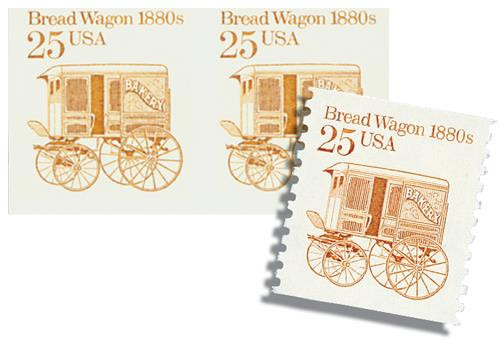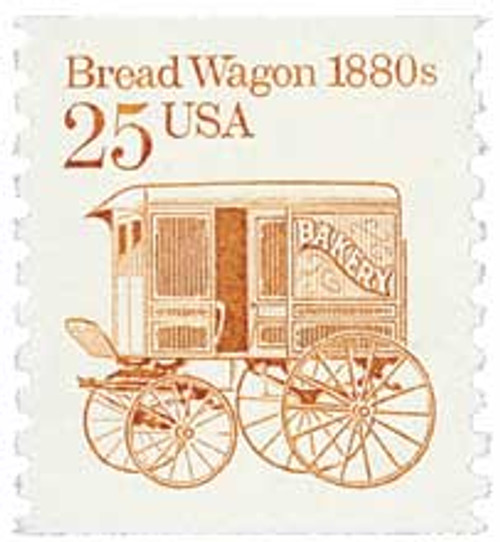
# 2136a - 1986 25c Bread Wagon, Error
U.S. #2136a
1986 25¢ Bread Wagon, 1880s
Imperforate Error
Transportation Series
- Imperforate error pair – only a few thousand known
- 27th Stamp in the Transportation Series
- Issued for use in Post Office vending machines
Stamp Category: Definitive
Series: Transportation
Value: 25¢; for larger envelopes and make-up rate on packages
First Day of Issue: November 22, 1986
First Day City: Virginia Beach, Virginia
Quantity Issued: A few thousand pairs known
Printed by: Bureau of Engraving and Printing
Printing Method: Engraved
Format: Coils of 3,000
Perforations: 10 Vertical
Color: Orange brown
Why the stamp was issued: For use in post office vending machines, especially those that offer mail services after hours. This stamp would have been used on large envelopes and packages that needed make-up postage.
About the stamp design: William H. Bond created the image for this stamp in pen and ink, based on a few archival drawings and photos.
First Day City: This stamp’s First Day ceremony was held at the VAPEX ’86 stamp show at the Pavilion Convention Center in Virginia Beach, Virginia.
About the Transportation Series: On May 18, 1981, the USPS issued the first stamp in the Transportation Series, US #1907, picturing the Surrey, a doorless four-wheeled carriage. For the first time in US history, a coil stamp featured its own unique design rather than simply copying that of the current definitive stamp. Over 50 more coil stamps would be issued over the course of the next 15 years, each picturing a different mode of transportation. All of these types of transportation were used since American independence.
The various denominations provided face values to exactly match the rates for several categories of Third-Class mail (bulk rate and quantity-discounted mail). As the rates changed, new stamps with new values were added. Never before had a stamp series included so many fractional cent values.
The Bureau of Engraving and Printing printed most of the stamps in the Transportation Series, although private contractors printed a few. All but a few of the later stamps were produced by engraved intaglio. Differences in precancels, tagging, paper and gum provide a large number of varieties.
Scott Catalog separates the Transportation stamps into four groups. The stamps in the first group (#1897-1908) generally have the denomination in small type with a “c” next to it. These stamps were printed on the Cottrell rotary press, which joined together two plates to make a sleeve. The gaps between these plates created depressions where ink would collect and create joint lines on the stamps. Later issues were printed on a different press and didn’t have these joint lines.
The second group (#2123-36) had larger numbers with no “c.” The third group (#2252-66) was similar in appearance to the second group, but service inscriptions were added to the designs. These stamps also used a variety of paper and gum as well as different types of tagging. The fourth group (#2451-68) marked the end of fractional values. Now bulk mailers would use either the 5¢ or 10¢ stamp and then pay the difference from the actual postage rate.
The last stamp in the Transportation Series, the 20¢ Cog Railway, was issued on June 9, 1995, at the TEXPEX ’95 stamp show in Dallas, Texas. This marked the end of the largest US definitive series up to that time. Three new series would eventually replace it – American Transportation, American Culture, and American Scenes. Additionally, the Great Americans would go on to become the largest American definitive series.
History the stamp represents: Used in the late 19th century, the bread wagon delivered commercially baked bread to individual homes and grocery stores. Although commercial bakeries had been established as early as 1640, most baking was still done in the home until the early 1900s.
U.S. #2136a
1986 25¢ Bread Wagon, 1880s
Imperforate Error
Transportation Series
- Imperforate error pair – only a few thousand known
- 27th Stamp in the Transportation Series
- Issued for use in Post Office vending machines
Stamp Category: Definitive
Series: Transportation
Value: 25¢; for larger envelopes and make-up rate on packages
First Day of Issue: November 22, 1986
First Day City: Virginia Beach, Virginia
Quantity Issued: A few thousand pairs known
Printed by: Bureau of Engraving and Printing
Printing Method: Engraved
Format: Coils of 3,000
Perforations: 10 Vertical
Color: Orange brown
Why the stamp was issued: For use in post office vending machines, especially those that offer mail services after hours. This stamp would have been used on large envelopes and packages that needed make-up postage.
About the stamp design: William H. Bond created the image for this stamp in pen and ink, based on a few archival drawings and photos.
First Day City: This stamp’s First Day ceremony was held at the VAPEX ’86 stamp show at the Pavilion Convention Center in Virginia Beach, Virginia.
About the Transportation Series: On May 18, 1981, the USPS issued the first stamp in the Transportation Series, US #1907, picturing the Surrey, a doorless four-wheeled carriage. For the first time in US history, a coil stamp featured its own unique design rather than simply copying that of the current definitive stamp. Over 50 more coil stamps would be issued over the course of the next 15 years, each picturing a different mode of transportation. All of these types of transportation were used since American independence.
The various denominations provided face values to exactly match the rates for several categories of Third-Class mail (bulk rate and quantity-discounted mail). As the rates changed, new stamps with new values were added. Never before had a stamp series included so many fractional cent values.
The Bureau of Engraving and Printing printed most of the stamps in the Transportation Series, although private contractors printed a few. All but a few of the later stamps were produced by engraved intaglio. Differences in precancels, tagging, paper and gum provide a large number of varieties.
Scott Catalog separates the Transportation stamps into four groups. The stamps in the first group (#1897-1908) generally have the denomination in small type with a “c” next to it. These stamps were printed on the Cottrell rotary press, which joined together two plates to make a sleeve. The gaps between these plates created depressions where ink would collect and create joint lines on the stamps. Later issues were printed on a different press and didn’t have these joint lines.
The second group (#2123-36) had larger numbers with no “c.” The third group (#2252-66) was similar in appearance to the second group, but service inscriptions were added to the designs. These stamps also used a variety of paper and gum as well as different types of tagging. The fourth group (#2451-68) marked the end of fractional values. Now bulk mailers would use either the 5¢ or 10¢ stamp and then pay the difference from the actual postage rate.
The last stamp in the Transportation Series, the 20¢ Cog Railway, was issued on June 9, 1995, at the TEXPEX ’95 stamp show in Dallas, Texas. This marked the end of the largest US definitive series up to that time. Three new series would eventually replace it – American Transportation, American Culture, and American Scenes. Additionally, the Great Americans would go on to become the largest American definitive series.
History the stamp represents: Used in the late 19th century, the bread wagon delivered commercially baked bread to individual homes and grocery stores. Although commercial bakeries had been established as early as 1640, most baking was still done in the home until the early 1900s.









